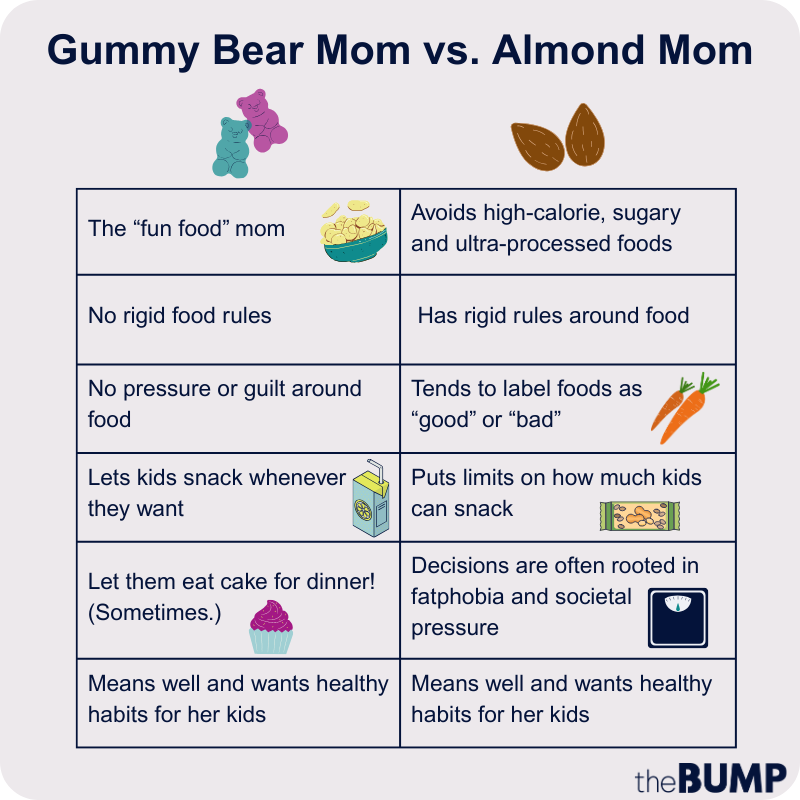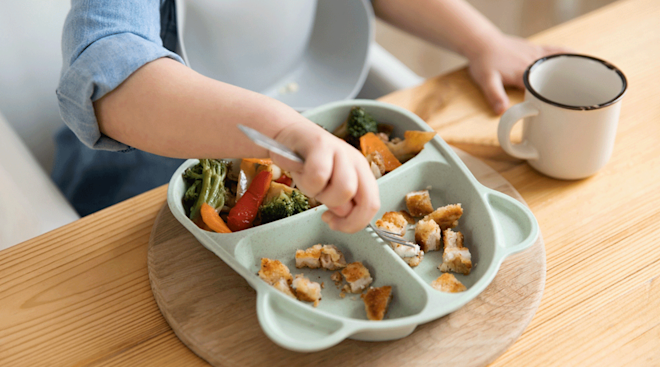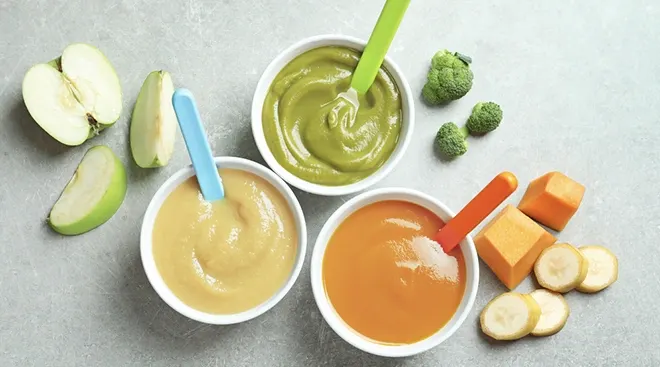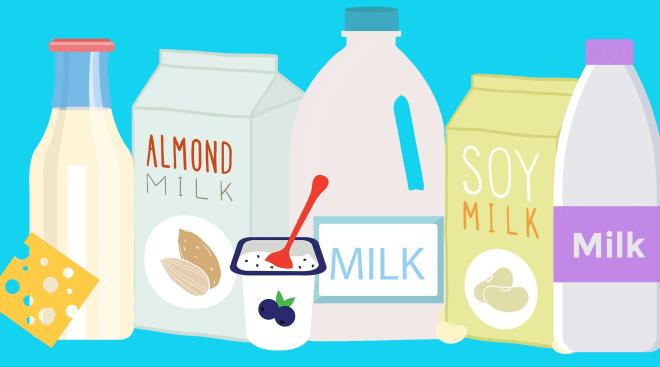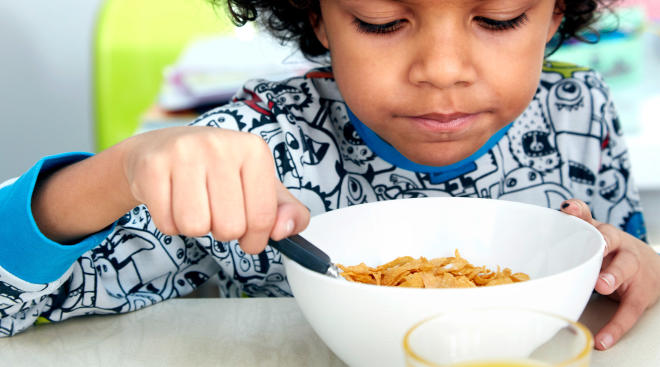Why You Don’t Want to Be Called an “Almond Mom” (and How to Reverse Any Almond-Mom Tendencies)
You might know an almond mom or two in your life. To this (extremely) conscious eater, bread might as well be an explosive device. Goodness forbid the yogurt isn’t plain, Greek and fat-free. And anything with sugar on it? She’d rather toss that freebie cupcake from a birthday party in the trash than give it to her child (who will definitely eat several at their friend’s house). The snacks are doled out in a very controlled way: If her toddler asks for one too close to dinner, they’ll just have to wait.
I used to skew toward the almond mom side of the kid-feeding divide. I steamed edamame for class snacks. My kids thought apples and peanut butter was a legit dessert for years. And, yes, I was the one who put out the crudité platter at the laser tag birthday party.
While I stand by most of my healthy food decisions, I now understand that it’s possible to mean well, but go over the top when it comes to trying to get your kids to build healthy-eating habits, and that restrictive eating habits can negatively affect a child’s attitudes toward food. Here, we talk to nutrition and child mental health experts—and parents like me—to understand where good intentions can cross a line, and how to foster healthy attitudes about food without creating anxiety and shame.
The term “almond mom” was born when a Real Housewife told her model daughter to “eat a few almonds” after she complained about feeling weak. But the phrase truly exploded on TikTok, with creator Tyler Bender’s viral series skewering moms who are fixated on healthy eating. In a nutshell, typical almond moms “avoid foods higher in calories, sugar or ultra-processed ingredients that lack nutrient density,” says Chacha Miller, RD, a maternal and pediatric registered dietitian and mom of two in Washington, DC. An almond mom might talk about how “fatty” certain foods are when at the dinner table or raise an eyebrow when someone picks up a piece of bread. With younger kids, it’s more about keeping them away from certain foods and maybe even restricting how much they can eat.
While the idea of eating healthy and limiting things like sugar is, well, healthy, here’s where things can get sticky: “These patterns are usually rooted in diet culture, food fear, fatphobia and the societal pressure to conform to the thin ideal,” says Miller. Translation: “Well-meaning ‘healthy habits’ can sometimes send a different message than we intend,” says Dani Lebovitz, MS, RDN, a pediatric registered dietitian, creator of Kid Food Explorers, and co-author of the forthcoming book Food Positivity: How to Ditch Diet Culture and Talk to Kids About Food.
Suffice it to say, if you’re referred to as an “almond mom,” it’s probably not meant as a compliment. The perception is that you deny yourself (and, likely, your kids) the opportunity to eat intentionally and wholly, impose unrealistic eating expectations and foster disordered eating habits at home, perhaps without even realizing it. If you see some “almond mom” in yourself, it’s understandable why you’ve absorbed this type of mentality. Whether your almond-mom tendencies come from your own parents or from society, there’s no reason to feel mom guilt over yet another thing—but it is important to examine your relationship with food so that you can pass on truly healthy habits to your kids.
You might be an almond mom if…
- If it has added sugar, it goes in the trash—even if you got it for free
- You bring your own healthy snacks to birthday parties and playdates
- Your kids can only snack at certain times
- Baby carrots are a treat
- Strawberries are dessert
It’s one thing to focus on whole foods and explain the importance of eating your veggies while keeping sugary snacks in moderation. But the healthy messaging can go too far—and while we can make our own diet choices as adults, they’re not always appropriate for kids’ bodies.
“More extreme messages like eliminating entire food groups—like dairy or grains—or cutting out macronutrients, such as carbs or fat, significantly increase a child’s risk of nutrient deficiencies,” notes pediatric dietitian Madison Tyler, RDN, owner of Nourish with Connection and a mom of two in Memphis. On top of that, restrictive food messaging can harm your child’s body image, their relationship with food and their overall wellbeing.
“By 3, children begin to absorb body-related stereotypes and by 5, many show signs of body dissatisfaction,” says Miller. “This is often rooted in the harmful narrative that we must control the size or shape of our bodies to be accepted or valued—and that the way to do that is by eating ‘good’ foods and avoiding ‘bad’ ones.” Even when you’re not explicitly talking about body size and weight, labeling foods “good” or “bad”—and putting conditions on food—sends a negative message.
“Young kids naturally think in black-and-white terms. When they hear a food is ‘bad,’ they may believe they’re bad for wanting it,” says Lebovitz. And restricting “bad” foods only makes them more desirable—so once kids have access, they might struggle with portion control. Then there’s the whole idea of making kids eat, say, broccoli before cookies, which only reinforces the idea that you have to “earn” certain foods, says Tyler. This creates a dieting mindset, causing shame, guilt and fear around food that can stick around for life, says Lebovitz. Worse, this can increase your child’s risk of binge-eating or other disordered eating behaviors. In fact, Tyler says that many adults who’ve struggled with eating disorders and body image were restricted from eating certain foods as children.
While I’ve been known to be a pseudo-almond mom (I avoided the whole “good” and “bad” vernacular), my friend Laura’s a gummy bear mom. “A gummy bear mom rejects diet culture and food rules, encouraging a more relaxed approach to eating where treats and processed foods are allowed without guilt or restriction,” says Miller. Or as Lebovitz puts it, “the gummy bear mom is the ‘fun food’ mom.”
At Laura’s house, dessert’s a given—and it never involves fruit. Kids can snack whenever they want, regardless of mealtime rules.
Another friend of ours, Elizabeth, is more of a butter mom. “These moms don’t follow strict food rules, but they prioritize traditional, often homemade meals using whole, high-fat ingredients,” says Miller. “While the butter mom and gummy bear mom philosophies both embrace an ‘all foods fit’ mindset, the butter mom often leans more toward scratch-made meals and steers away from packaged or ultra-processed foods.” Truth: Some of the best food I’ve eaten has come out of Elizabeth’s kitchen.
During COVID, when nabbing my go-to groceries was a challenge, junk food brought us unexpected joy. Pop-Tarts, chocolate milk and white bread became pantry staples—and taught me it was okay to loosen up. You don’t need to entirely drop your healthy instincts. But finding balance is important in order to improve your kids’ relationships with food—and your own. Here are some expert-recommended tips to help you change any almond mom tendencies:
Start small
Ease up outside the home, especially at parties and school events. “School serves packaged foods with more sugar than I’d like,” says Lauren H., an Atlanta mom of two. “But I remind myself that my kids are well-cared for while I work.” She brings healthier options for school parties, but has decided that she won’t freak out about birthday cupcakes. “Those moments create important memories too,” she says. Kate W., mom of one in New York City, takes a similar approach: “Trying to say no without creating awkward social situations can be a challenge, and I try to have better-quality snacks he loves on hand anytime we’re out. I don’t panic if he grabs some [junk food] from another kid, but I don’t offer it to him either.”
Drop the modifiers
“Use neutral language when talking about food, avoiding ‘good’ or ‘bad,’ ‘healthy’ or ‘unhealthy,’” says Miller. She explains that these labels can cause kids to internalize judgment around eating. Instead, describe what foods do rather than what they are, like “This food gives you energy for playing” or “Fruit gives us vitamins.” Or simply keep it educational by saying things like, “Your body needs different kinds of food to grow.”
Consider context
Kids carry our food judgments to school, where comments can hurt friendships and create unnecessary guilt. Every family’s food journey looks different—shaped by culture, access and circumstances. For example, 19 million Americans face real challenges accessing varied food options. Understanding this broader picture helps us talk about food with more compassion and less judgment.
Honor growth and say “yes” to snacks—within reason
Don’t automatically deny a snack as a matter of habit. Tyler notes that “children’s bodies and minds are growing and developing at much faster rates… They require more energy per kilogram of body weight than adults.” This growth powers everything from building bones to racing through playgrounds to focusing in class. So, yes, your child naturally gets hungry between meals—their bodies are telling them exactly what they need.
Drop the food bribes
Phrases like “Just try one bite” or “No dessert unless you eat your veggies” can turn food into a power struggle. “Kids learn best when mealtimes feel safe—not like a test they have to pass,” says Lebovitz.
Refrain from commenting on portion sizes
Even innocent-seeming phrases like “You didn’t eat enough” or “Wow, you ate all that?” can shift the focus away from their internal cues.
Don’t label your child a picky eater
“Instead, try ‘they’re still learning about food,’ which shifts from frustration to curiosity—and makes space for growth,” says Lebovitz. BTW, an authoritarian approach to food (“You can’t leave the table until you finish your carrots”) is actually linked to more picky eating, says Lebovitz.
Building healthy food relationships starts early and requires patience, consistency and a thoughtful approach. Need help getting there? Here are some expert-approved tips:
Create opportunities for involvement
“In our household, we have a system of participation in making dinner. Each of our children comes up with a balanced dinner idea weekly that we then negotiate together, shop for together, construct at home together and share together,” says Michael Adelman, MD, a board-certified child and adolescent psychiatrist with Mindpath Health and father of six.
Focus on connection
“The most significant factor in human health and happiness is connection—not diet,” says Tyler. Research shows families who share frequent meals together enjoy better nutrition, stronger family relationships and mental health—a win for everyone! Make mealtime about sharing stories and laughter, prioritizing family bonding over nutrition lectures.
Find your sweet spot
“Try to keep it in balance,” says Lauren H. When her kids are hungry between meals, she always offers a filling and healthy snack, packed with fiber and protein, first. “If you’re still hungry, you can have something a little less healthy—like a cheese stick before a granola bar that’s higher in sugar.”
Engage kids’ senses
“When you’re exploring foods together, talk about how it smells, how it feels in your mouth, its texture, temperature, color or taste. This helps kids build a vocabulary around food, so they can express their preferences more clearly,” says Miller. “Plus, these kinds of conversations promote curiosity and mindful eating, which helps kids tune in to their internal cues and respond to food in a way that feels comfortable and natural.”
Offer a variety of foods
Put different foods on the table—even ones you’re unsure they’ll try—and make exploration the goal rather than consumption, advises Lebovitz.
Be a good role model
Remember, our kids are watching. Even if you’re just restricting your own food intake, your kids will notice. As Miller explains, “Our children learn the most from watching us, so modeling the relationship we hope they develop with food, one that’s relaxed, curious and rooted in trust, is one of the most powerful tools we have.” This includes letting your child see you honor your hunger, fullness and preferences. “Say things like: ‘I’m full, so I’ll save this for later’ or ‘This tastes really good to me today,’” says Lebovitz.
Let go of perfection
“Sometimes we have ice cream with breakfast, and sometimes dinner doesn’t include a vegetable—and that’s okay,” says Lebovitz. Like many parents, she felt that quiet pressure to get everything “right,” from portion sizes to snack choices. Now she aims for balance: serving varied foods without shame, setting kind boundaries and trusting her children to listen to their bodies. “It’s about being warm and responsive while maintaining helpful structure, not hitting an impossible standard of perfection,” she says.
Almond mom is a catchy social media term. But it’s important to remember that these labels are just that—labels. “Rather than subscribing to a single food philosophy, I recommend focusing on variety,” says Miller. “Let your kids explore different foods and develop their preferences in an environment free from pressure or shame.”
So whether you’re an almond mom, gummy bear mom or “I just need to feed my kids after a long day” mom, the key is balance—making room for both nutrition and joy so that kids can develop a healthy relationship with food that lasts a lifetime.
Please note: The Bump and the materials and information it contains are not intended to, and do not constitute, medical or other health advice or diagnosis and should not be used as such. You should always consult with a qualified physician or health professional about your specific circumstances.
Plus, more from The Bump:
Michael Adelman, MD, is a board-certified child and adolescent psychiatrist with Mindpath Health and father of six based in Cary, North Carolina. He earned his medical degree from the University of North Carolina at Chapel Hill School of Medicine.
Dani Lebovitz, MS, RDN, is a pediatric registered dietitian, creator of Kid Food Explorers, and the co-author of the forthcoming book Food Positivity: How to Ditch Diet Culture and Talk to Kids About Food.
Chacha Miller, RD, is a maternal and pediatric registered dietitian and mom of two in Washington, DC.
Madison Tyler, RDN, is a pediatric dietitian, the owner of Nourish with Connection and a mother of two in Memphis.
Preventive Medicine, Family Meals Along Parents: Associations with Nutritional, Social and Emotional Wellbeing, May 2018
The Annie E. Casey Foundation, Communities with Limited Food Access in the United States, August 2024
White Pine Center for Healing, What Is An Almond Mom? Meaning, Behaviors, & Diet Culture, March 2025
Real-parent perspectives:
- Kate W., mom of one in New York City
- Lauren H., mom of two in Atlanta
Learn how we ensure the accuracy of our content through our editorial and medical review process.
Navigate forward to interact with the calendar and select a date. Press the question mark key to get the keyboard shortcuts for changing dates.

































